
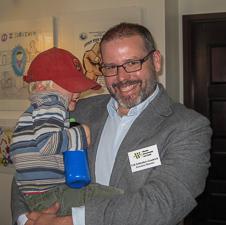
Each year, WELC also produces a traveling Wild & Scenic Film Festival, bringing inspiration films to communities throughout the United States in hopes of bringing people together to help our earth. One of the numerous places the Film Festival comes to is the little town of Taos, New Mexico, home to WELC's Southwest office and where WELC's executive director, Erik Schlenker-Goodrich, resides. As the executive director of Izilwane—Voices for Biodiversity and as a Taoseño, I wanted to see how other environmental organizations were working with the medium of film for storytelling, how a traveling film festival worked as a fundraising mechanism for WELC, and to let others know of WELC's successful and fun work.
Dina Gonzales, administrative coordinator, graciously made sure that I had free passes to the programming. The matinee events focused on films for and about youth. Each film was interspersed with a few words from Erik about WELC's work and the films and what they hope to teach America's next generation about the needs of our environment. Many of the films can be seen on Vimeo or YouTube, so I've included the links of those films so that our audience can enjoy them online. In essence, you can almost attend the festival as I walk you through it in this article. Bring your kids; these films are sure to impress them! 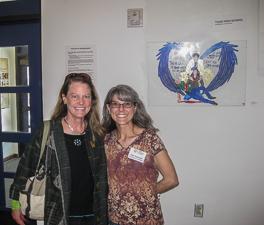
The first film, Moonwalk, was visual eye candy. Dean Potter tight-rope walks on Cathedral Peak in Yosemite National Park after the sun sets and as the moon rises. National Geographic had a project titled The Man Who Can Fly, and this film was part of that larger project. If you're afraid of heights, this could make you squirm.
Moonwalk was followed by a heartwarming film about Jacob Glass, a recipient of the Brower Youth Awards, and his efforts to create a wilderness area designation for Scotchman Peaks, Montana. The Scotchman Peaks are an 88,000-acre roadless area on the Idaho-Montana border. Jacob and his friends were filmed and also shot their own footage as they explored the rugged mountains with plein air painters. What I particularly liked about this film was that Jacob, the narrator, made the audience aware that he was making a film, was being filmed, was following painters who were painting the wilderness, and that he understood the power of mixing these multi-layered perceptions as a way to illustrate how different people could value the peaks in different ways.
Stories of Trust: Calling for Climate Recovery followed Jaime Lynn Butler, an 11-year-old Navajo artist, reflecting upon the need for the White House and other government and political agencies and actors to recognize that they hold a responsibility for the public trust placed in them to mitigate climate change and its environmental consequences. Jaime and other young people across the country launched legal action in 49 states against state and federal governments to address climate change. The film series about these youths was a coordinated effort of Witness.org, Our Children's Trust , the iMatter Campaign, and students from Montana State University's MFA in Science and Natural History Filmmaking. Taos's own Sean Solowiej, who recently moved to new Mexico, was involved in making these films and teaches at University of New Mexico-Taos. He also started MediaTaos.org, which operates the town's cable access station on Comcast cable channel 22. 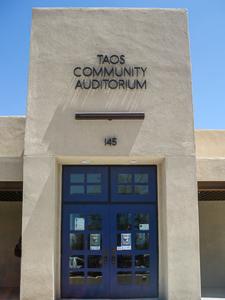
The next film Eyes in the Forest: The Portraiture of Jim Lawrence was one of my favorites. In this movie, Miriam Needoba follows Jim Lawrence, a photographer, on his daily rounds of taking photographs in the Selkirk Mountains of British Columbia. The film had exquisite footage of wildlife and scenery and captured the photographer's small moments of connection and peacefulness in nature as well as his concern that we are losing so much biodiversity. If we could value this type of connection, we could transform our way of being in the world, question our current assumptions and lifestyles, and move into a more coherent pattern of coexistence with the natural world and the other species that inhabit it.
After a rousing film about WELC's work, which explained the organizations history and current work, we broke for intermission. In the lobby, I came across an incredibly beautiful white German Shepherd, Zatoichi, who worked as a Taos Search and Rescue dog. In addition, the usual Taos faces were there in the lobby, including the popcorn lady, Annette McClure, who has volunteered at the Taos Center for the Arts for years and who is a stalwart environmentalist.
After intermission, the entertainment continued. The Gimp Monkeys was about three disabled climbers, Craig DeMartino, Jarem Frye and Pete Davis, who refused to let their disabilities get in the way of a successful ascent of Zodiac, a 1,800-foot route on the southeast face of El Capitan in Yosemite National Park. This was my second favorite film of the day. It was refreshing to see adults overcoming such difficulties, and the film was funny because of the climbers' healthy and sometimes self-deprecating sense of humor.
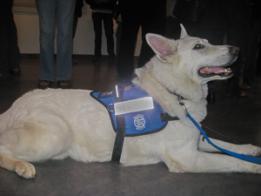
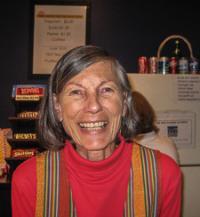
The finale film for the matinee was How Kids Saved the Parks, a truly poignant and often funny film best described by the filmmakers: "You know those movies where the kids get together and do something awesome? When they unite to overcome insurmountable odds? Maybe win the championship from the favored bad guys. Maybe embark on an epic quest to stop the grownups from doing something stupid. This is one of those movies, except this one really happened. This is the story of a group of great kids that worked day and night to save the California State Parks that they love – this is 'How the Kids Saved the Parks'."
So what did I learn about and from WELC's Wild & Scenic matinee? First of all that one way to get to parents is through their kids and that law makers, policy makers, and government are often more influenced by youth than adults. I'm not sure if this is good or bad. Does it mean that adults have given up on being heard? Does it mean that parents want their kids to speak for them? Or does it mean that local, state, and federal governments won't listen to adults insist that the natural world should be saved for its intrinsic beauty and value, that such an attitude is considered somehow childish? Who knows? What I can tell you is that about a third of the audience was made up of younger people and they seemed to really enjoy the festival. The message the matinee got across was pretty simple: Move over. Kids rule. And they're having fun doing so.
All photos are copyright protected and may not be used without permission. All photos are courtesy of Tara Waters Lumpkin.